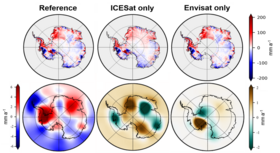Sensitivity of Glacial Isostatic Adjustment Estimates over Antarctica from Satellite Observations & Model Outputs
The present-day signal due to glacial isostatic adjustment (GIA) is of special interest for sea level research. GIA is a component of the sea level budget and it leads to gravity changes that need to be carefully considered when evaluating mass changes from time-variable gravity fields. We investigated the combination methodology approach from Gunter et al. (2014) which allows estimating GIA from satellite gravimetry and satellite altimetry observations over ice sheets. In this combination of satellite data, processes in the snow/firn layer are accounted for by the surface mass balance output from regional climate modelling and the elevation change product from firn densification modelling.

Within the OMCG project, a paper published by Willen et al. (2020) presents findings of a sensitivity study where they tested a variety of processing choices and data products. (1) implementing external degree-1 and C20 products in GRACE gravity fields, (2) incorporating various satellite altimeter missions during GRACE observation period (Fig. 1), (3) empirically estimated uncertainties of model outputs, and (4) the correction for apparent biases. Further, Willen et al. (2020) pointed out limitations associated to data quality, data processing, and correction for apparent biases. They estimated the GIA signal from observations over almost the entire GRACE observation period and we developed the approach to combine time series of the satellite observations and model outputs.
The findings demonstrate the significant challenges quantifying the Antarctic ice mass change from combined satellite observations and model outputs.
References
Gunter, B. C., Didova, O., Riva, R. E. M., Ligtenberg, S. R. M., Lenaerts, J. T. M., King, M. A., van den Broeke, M. R., and Urban, T.: Empirical estimation of present-day Antarctic glacial isostatic adjustment and ice mass change, TC, 8, 743–760, doi.org/10.5194/tc-8-743-2014, 2014.
